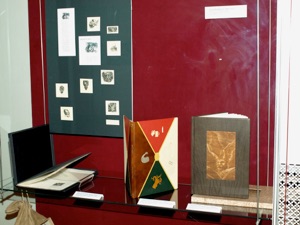Pavlov & Devil’s Rock

Binding by Jan Sobota
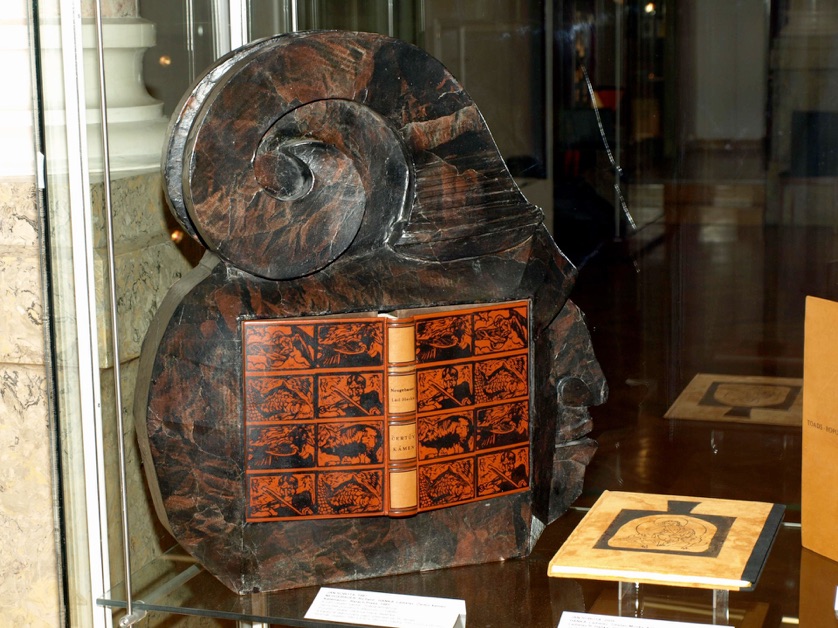
Devil’s Rock and Pavlov are both printed in Czech, published in small editions and as such, unique examples of Czech bibliophilia done outside the Czech Republic. Being bound by Jan Sobota makes them furthermore complete in the sense of being an ethnic creation with a Czech binder participating as well. Now the circle has been closed by bringing the work back to the land of its origin.
Čertův kámen (Devil’s Rock)
Richard Neugebauer & Ladislav Haňka :
Rarach Press, Kalamazoo, 1981
100 pp letterpress with 27 wood engravings
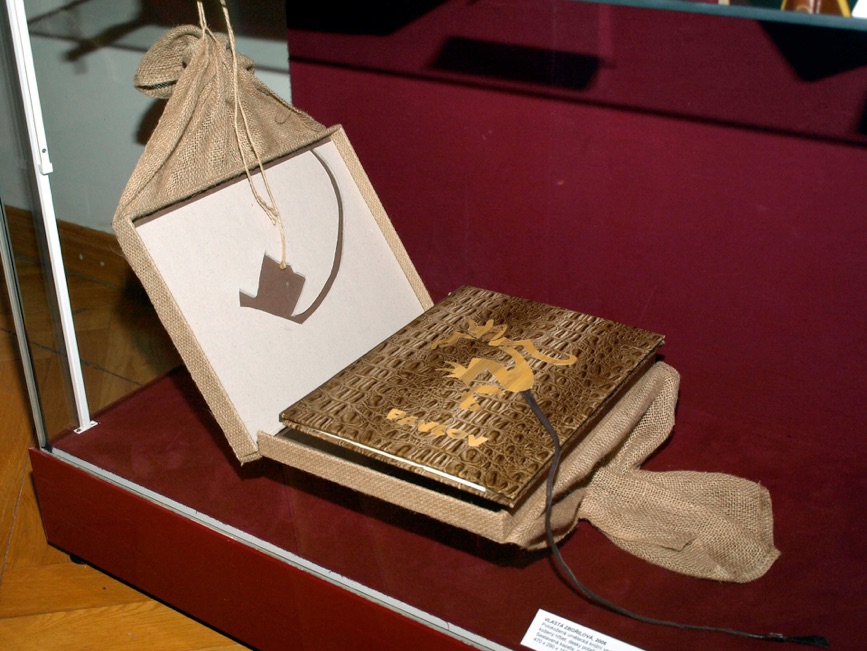
Neugebauer’s voice is itself of historical and ethnographic interest in that his is clearly a late 19th century/ early 20th century attitude to the written word and folklore. He was mostly a self-taught lover of his culture rather than an academic and held many of the assumptions and attitudes of his time and station. His verse is all in disciplined trochaic hexameters, typical for Czech and tends to reflect a delicate sensibility with nods to Greek and Latin mythology, mildly off-color implications circumlocuted in humorous ways and takes delight in political innuendo about the communist regime that is discrete, but unmistakable. The linotype was set at the Voice of the Nation - (Hlas Národa), a Chicago Catholic weekly whose producer , father Vojtěch Vít, appreciated the ethnographic worth of the literature and helped bring it to life. A trade edition later appeared, published by Ladislaus Bolchazy, a Slovak scholar ordinarily publishing the classics.
On Devil’s Rock and Pavlov -
their value as folklore and as a springboard for my entry into Czech Book Arts culture
Devil’s Rock was my MFA degree work (Master of Fine Arts). My first two Czech-language books are however primarily significant in that they are original records of folk-tales collected in the early part of the 20th century from the Czech-Moravian highlands. Folk-tales often show up in many locations, but are of interest in the ways that details differ in various regions and countries. Here the collector is my grandfather, Richard Neugebauer. He was a pre-war sawmill owner in a rural district and was able to collect stories from an as yet intact oral tradition. Some of the tales appear to be unique to these isolated highlands straddling Bohemia and Moravia. He later set a selection of these stories to verse - all of them dealing with the machinations of the Devil in village life, as he plays upon human weakness to lure the souls of the unwary into his clutches. Many of the stories are Czech varieties of the Devil and Daniel Webster story, in which people also get the better of the Devil.
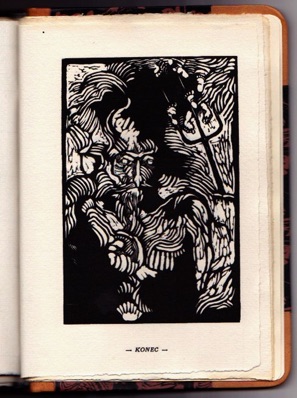
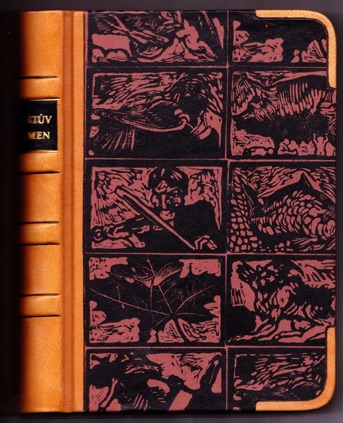

Čertův Kámen - Konec - The End
Čertův Kámen - Binding by Jan Sobota
Pavlov - Binding and medieval monastic-style bag-contained slip-case by Vlasta Zbořilová.
I saw the nascent book arts movement of the late 70's as a vehicle for preserving some folklore and my grandfathers’ manuscripts as well as an interesting way of presenting my own graphic art. There were no people of whom I knew doing this sort of work and unlike students today, enrolling in book arts degree programs, I was typical of the early practitioners who were mostly self taught – in essence laboriously rediscovering the wheel all over again. The earliest works, such as Devil’s Rock are indeed quite primitive and look like the work of an autodidact with all the charm and shortcomings that usually implies.
It was the full page article on Devil’s Rock in the American book arts journal Fine Print, that led to my contact with Jan Sobota - the only person to respond to this generous review. We exchanged some letters with uncertain promises of future contacts until the day I surprised Jan and Jarmila in their Cleveland driveway returning from the bar late one evening, addressing them as citizen, with a demand for their papers. A moment of panic ensued, followed by the realization that this cannot be. We spent the night with some more drink and talk and have never stopped hatching plots and making art.
Books as art have a long tradition in the Czech Republic and the standards there are high. The Czech hand-made book has kept its exceptional quality through an apprenticeship system of master binders, papermakers, contract printers, typecrafters and designers as well as living letterpress workshops, surviving with few interruptions into the present day. The letterpress shop at Vimperk was for instance active well into the 1990’s, producing countless bibliophilic imprints for many publishers. Lyra Pragensis, the Krupka’s Press and Bonaventura Editions continue to keep this tradition alive to this day and thus the works of many Czech artists have been widely disseminated through this vehicle. The hand-made papermakers, whose flagship is at the Baroque estates of Velké Losiny, have kept alive rag paper-making at an exceptional level since at least 1596 (the oldest known watermark from the mill). Czechoslovakia was blessed with a high survival rate of these crafts into the present day, when they are once again finding appreciation and being revived. These two early efforts at Czech-language books coming from the unlikely location of Michigan are therefore a part of a much longer tradition, one with the power to inspire a young American student and which has led to this 25 year long aesthetic collaboration - one which continues across the Atlantic to this day.
Ladislav R. Haňka
In my researching of emigre publishers, I’ve yet to find another fine art letter press printer working in Czech outside the Czech Republic. This appears to be a unique effort, but one which is saved from being a mere curiosity by virtue of the material being both significant as well as unpublished. It was produced to create a record which might otherwise die. The author, was a former member of the bourgeoisie in a communist state and thus unpublishable for political reasons. There are many commercial publishers of Czech throughout the USA, Canada and countries with significant emigre communities, but no hand printers aside from myself. The nearest thing was Edice Archa in Munich, which for several years printed inexpensive miniature editions of Czech poetry from linotype in the early 1980's, but without artwork or bindings.
Čertův Kámen - Binding by Jan Sobota
Pavlov - one bound copy remains NFS
Čertův kámen (Devil’s Rock)
2 bound copies by Jan Sobota (depicted
above) on hand-made paper from Velke
Losiny: 8,000.00 each
1 bound by L Hanka on vegetal parchment
paper 6,000.00
4 library bindings in buckram on Howard
Permalife paper 1,000.00 each

